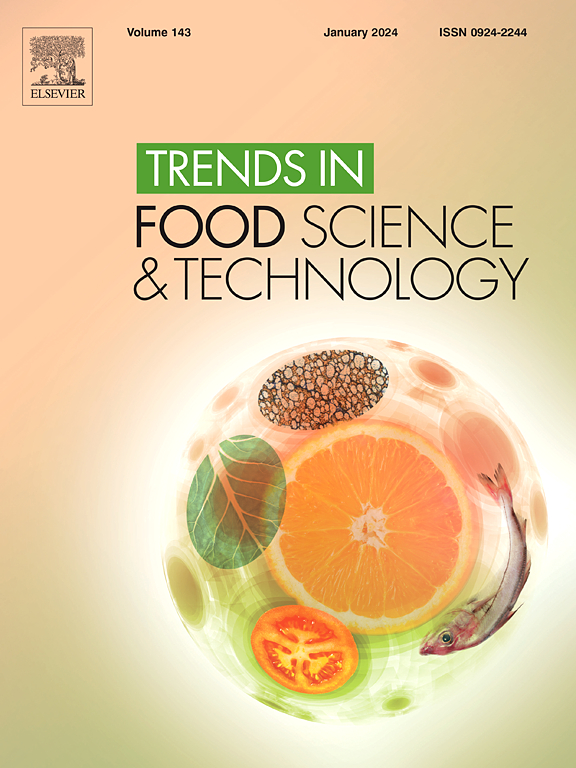Overview of clams packaging systems sustainability
IF 15.1
1区 农林科学
Q1 FOOD SCIENCE & TECHNOLOGY
引用次数: 0
Abstract
Background
This work analyses the protection requirements and options for primary and transportation packaging of shellfish. It considers the properties of materials and the most recent developments and innovations in the arena created by legislation shaping packaging practices and frameworks of circularity and sustainability. A short review of the environmental profiles of typical packaging systems is provided. Fresh clams must be alive when sold, and the shelf-life period is defined based on the time the clams are alive. This product is highly perishable and valued, and losses and waste must be reduced.
Scope and approach
a multidisciplinary approach was followed, bringing together data from the product, material properties, and packaging design. These were integrated in the analysis of the impact of non-fossil plastic alternatives, reusability, recyclability and incorporation of recycled in the clams packaging. This work provides a global view of the packaging system, focusing not only on the materials developments but also on the trends regarding primary packaging, labels, and secondary packaging for transport. Scientific reports from the last 10 years were used as well as an interview with major stakeholders in Europe (a retailer and a packaging supplier).
Key findings and conclusions
there are a large body of research dedicated to studying the shelf-life of other bivalves, but studies focusing on clams are scarce. Furthermore, many studies do not consider the FAO recommendations on the need to keep the clams alive up to the purchasing time, and therefore conclusions are biased because they are based on monitoring parameters that are less relevant for this product. Novel packaging materials, such as bioplastics and bio-polymers functionalised with smart components seem very attractive and they have been targeted in several reviews and many published studies. However, results reported show that there is a gap between the performance required and effectively delivered by many of these new developed materials. Much less effort has been dedicated to optimising the more traditional materials, to improve their recyclability, thereby extending the usage cycle to save resources. This research need has been clearly identified for transportation packaging, particularly foamed materials, crucial for thermal insulation, and for nets used for primary packaging of bivalves. Optimisation of the mechanical properties under humid conditions are needed to permit the use of biobased materials, such as cellulosic fibres, as clams nets. MAP technology is not a sustainable solution for increasing the shelf-life of clams. The barrier materials required and the limited recyclability represent an unbalanced environmental impact. A critical analysis of the environmental profiles associated with different packaging systems highlights challenges and opportunities within the industry when addressing sustainability. This review provides insights into current trends, challenges, and future directions in clams packaging, promoting informed decision-making and fostering sustainable practices in the packaging industry.
蛤蜊包装系统可持续性概述
本工作分析了贝类初级包装和运输包装的保护要求和选择。它考虑了材料的特性以及立法塑造包装实践和循环和可持续性框架所创造的舞台上的最新发展和创新。简要回顾了典型包装系统的环境概况。新鲜的蛤蜊在出售时必须是活的,保质期是根据蛤蜊的活时间来确定的。这种产品很容易腐烂,也很有价值,必须减少损失和浪费。范围和方法遵循多学科方法,将产品,材料特性和包装设计的数据汇集在一起。这些都被纳入了对非化石塑料替代品的影响、可重复使用性、可回收性和在蛤蜊包装中纳入可回收材料的分析。这项工作提供了包装系统的全局视图,不仅关注材料的发展,而且关注关于初级包装、标签和运输二次包装的趋势。过去10年的科学报告以及对欧洲主要利益相关者(零售商和包装供应商)的采访被使用。主要发现和结论有大量的研究致力于研究其他双壳类动物的保质期,但对蛤蜊的研究很少。此外,许多研究没有考虑到粮农组织关于需要保持蛤蜊存活到购买时间的建议,因此结论是有偏见的,因为它们是基于与该产品不太相关的监测参数。新型包装材料,如生物塑料和生物聚合物功能化的智能组件似乎非常有吸引力,它们已经在几篇评论和许多已发表的研究中成为目标。然而,报告的结果表明,许多这些新开发的材料所要求的性能与有效交付之间存在差距。在优化更传统的材料,提高其可回收性,从而延长使用周期,节省资源方面的努力要少得多。对于运输包装,特别是对隔热至关重要的泡沫材料,以及用于双壳类动物初级包装的网,已经明确确定了这项研究需要。需要在潮湿条件下优化机械性能,以允许使用生物基材料,如纤维素纤维,作为蛤网。MAP技术不是延长蛤蜊保质期的可持续解决方案。所需的屏障材料和有限的可回收性代表了不平衡的环境影响。对与不同包装系统相关的环境概况进行了批判性分析,强调了解决可持续性问题时行业内的挑战和机遇。这篇综述提供了当前的趋势,挑战和未来的方向在蛤蜊包装,促进知情的决策和促进可持续的做法在包装行业的见解。
本文章由计算机程序翻译,如有差异,请以英文原文为准。
求助全文
约1分钟内获得全文
求助全文
来源期刊

Trends in Food Science & Technology
工程技术-食品科技
CiteScore
32.50
自引率
2.60%
发文量
322
审稿时长
37 days
期刊介绍:
Trends in Food Science & Technology is a prestigious international journal that specializes in peer-reviewed articles covering the latest advancements in technology, food science, and human nutrition. It serves as a bridge between specialized primary journals and general trade magazines, providing readable and scientifically rigorous reviews and commentaries on current research developments and their potential applications in the food industry.
Unlike traditional journals, Trends in Food Science & Technology does not publish original research papers. Instead, it focuses on critical and comprehensive reviews to offer valuable insights for professionals in the field. By bringing together cutting-edge research and industry applications, this journal plays a vital role in disseminating knowledge and facilitating advancements in the food science and technology sector.
 求助内容:
求助内容: 应助结果提醒方式:
应助结果提醒方式:


